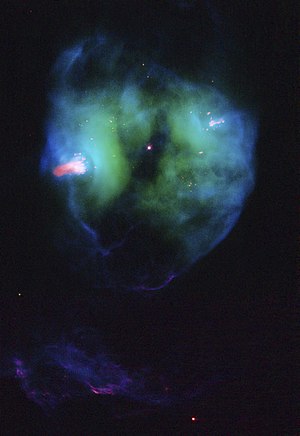NGC 2371 and NGC 2372
|
Planetary nebula NGC 2371 and NGC 2372 |
|
|---|---|

|
|
| Photo from the Hubble Space Telescope | |
| AladinLite | |
| Constellation | Twins |
|
Position equinox : J2000.0 |
|
| Right ascension | 07h 25m 34.6s |
| declination | + 29 ° 29 ′ 26 ″ |
| Appearance | |
| Apparent brightness (visual) | 11.2 mag |
| Apparent brightness (B-band) | 13.0 likes |
| Angular expansion | 1.03 ′ × 1.03 ′ |
| Central star | |
| designation | CSI + 29-07225 |
| Apparent brightness | 15.5 mag |
| Physical data | |
| Redshift | 0.000070 ± 0.000017 |
| Radial velocity | (+21 ± 5) km / s |
| distance | 4300 ly |
| history | |
| discovery | Wilhelm Herschel |
| Date of discovery | March 12, 1785 |
| Catalog names | |
| NGC 2371/2372 • GC 1519/1520 • H II 316 / II 317 • h 444/445 • PK 189 + 19.1 | |
NGC 2371 is a planetary nebula in the constellation Gemini , located approximately 4,300 light years from Earth .
The planetary nebula NGC 2371 was discovered on March 12, 1785 by the German-British astronomer Friedrich Wilhelm Herschel .
Web links
Commons : NGC 2371 - collection of images, videos, and audio files
- Hubble Space Telescope
- Astronews
- High-resolution image of the nebula with a semi-professional amateur telescope